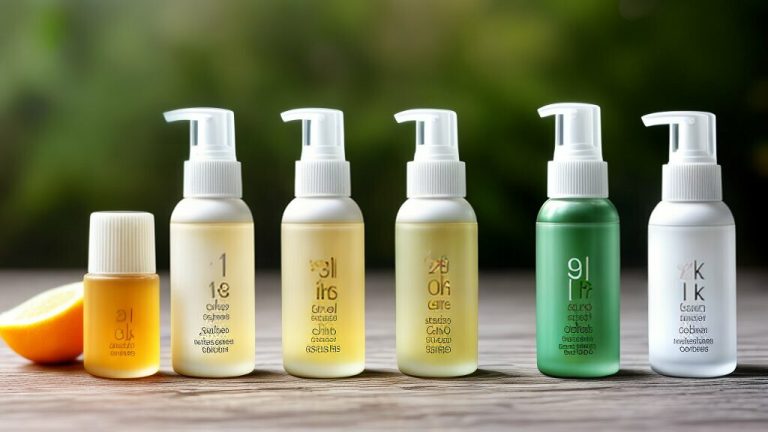When to Use Hyaluronic Acid Serum in Routine: Expert Tips
The hyaluronic acid serum has become a must-have in many people’s skincare routines due to its exceptional hydrating properties. It is a powerful humectant which attracts moisture onto the skin, leaving it plump and supple. However, like other skin care products, using it at the right time is essential to get the best results.
In this article, we will discuss when to use the hyaluronic acid serum in your routine and share some expert tips on how to get the most out of this fantastic skincare ingredient.
Key Takeaways
- The hyaluronic acid serum is a powerful humectant that attracts moisture to the skin.
- Using it at the right time is essential to get the best results.
- Incorporating hyaluronic acid serum into your daily skincare routine can provide numerous benefits, including hydration, plumping effects, and improving skin texture and elasticity.
- It is crucial to follow the proper guide of application of techniques to ensure maximum absorption and effectiveness.
- Consider your skin type, climate, and personal preferences to determine the appropriate frequency of hyaluronic acid serum application in your routine.
Incorporating Hyaluronic Acid Serum in Your Skincare Routine
When incorporating a hyaluronic acid serum into your skincare routine, starting with a clean base is essential. Make sure to thoroughly cleanse and tone your skin before applying the serum to allow for optimal absorption.
Once your skin is prepped, start with a few drops of hyaluronic acid serum to both your face and neck, gently patt it into the skin. It’s best to use the serum while your skin is still slightly damp, such as after toning or misting with a facial spray, to help lock in hydration.
If you’re using other skincare products, such as moisturizers or oils, wait a few minutes before applying them to the serum to let it fully absorb. Layering products in the correct order is critical to maximizing their efficacy.
For those with drier skin, it may be beneficial to apply hyaluronic acid serum twice daily, both morning and evening. Those with oilier skin may find once a day is sufficient. Ultimately, the frequency of the use of Hyaluronic will depend on the skin type and preferences.
Optimal Time to Apply Hyaluronic Acid Serum
The best time of day to apply hyaluronic acid serum is after cleansing and toning your skin. This process will allow the serum to penetrate deeply into the skin and provide optimal hydration. Applying the serum before any other skincare products is recommended to allow it to absorb into the skin thoroughly.
Hyaluronic acid serum can also be applied at night before bed, as it helps repair and regenerate the skin while you sleep. During the day, using hyaluronic acid serum can provide added moisture and protection against environmental stressors.
It is important to note that the efficacy of hyaluronic acid serum can be amplified if used consistently over time. Therefore, it is recommended to use it daily or as often as needed to maintain optimal hydration levels in the skin.
Hyaluronic Acid Serum Usage Recommendations
Hyaluronic acid serum application frequency depends on an individual’s skin type, climate, and preference. For optimal hydration, experts recommend applying the serum twice daily, once in the morning and once in the evening.
If you struggle with dry skin, consider increasing the frequency of application to three times a day. On the other hand, if you have oily skin, you may prefer to use hyaluronic acid serum only once a day or every other day.
It’s important to note that too much hyaluronic acid serum can be counterproductive and make your skin feel sticky or heavy. Generally, one to two drops of the serum cover your entire face and neck.
Additionally, it’s essential to consider the other products in your skincare routine when determining the frequency of hyaluronic acid serum use. If you’re using other moisturizers or serums that contain hyaluronic acid, you may not need to use the serum as often.
It’s best to listen to your skin and adjust the frequency of hyaluronic acid serum application as needed.
Hyaluronic Acid Serum Application Tips
Proper application of hyaluronic acid serum can significantly affect its effectiveness. Follow these expert tips to ensure maximum absorption and hydration:
- Apply the serum to clean dry skin. Ensure your face is free of debris from previous skincare products or makeup.
- Take a pea-sized amount of the product and spread it evenly across your face, focusing on areas that need extra hydration, like the cheeks, forehead, and chin.
- Rub the serum gently into your skin using circular motions. This allows for better absorption and stimulates blood flow.
- For best results, wait a few minutes before applying additional skincare products.
Expert tip: Try layering the hyaluronic acid serum on damp skin for enhanced hydration. Spritz your face with a facial mist or use a wet towel before applying the serum.
When using other skincare products alongside a hyaluronic acid serum, be mindful of the order in which you apply them. It’s generally recommended to apply serums before heavier creams or lotions.
Customize your application routine based on your skin’s specific needs and preferences. Experiment with different amounts and application of HA to find what works best for you.
Hyaluronic Acid Serum Benefits
The hyaluronic acid serum has become a staple in many skincare routines thanks to its numerous benefits for the skin. Here are some of the most notable benefits you can expect from using hyaluronic acid serum:
| Benefit | Description |
|---|---|
| Hydration | Hyaluronic acid is a humectant that can attract and hold onto moisture from the environment. This helps keep the skin plump, soft, and hydrated. |
| Plumping | As the skin becomes hydrated and moisturized, it can appear fuller and more youthful. Hyaluronic acid may help plump up the skin, reducing the look of fine lines and wrinkles. |
| Improved texture | With regular use, hyaluronic acid serum will help you to refine the tone and texture of the skin. It may reduce dryness, flakiness, and dullness, leaving the skin looking smoother and brighter. |
| Boosted elasticity | Hyaluronic acid can also help enhance the skin elasticity, making it more resilient and less prone to wrinkles and sagging. This will give the skin a more youthful |
The hyaluronic acid serum is a versatile and effective skincare ingredient that can benefit almost any skin type. Incorporating HA into your daily routine will allow you to enjoy smoother, plumper, and more hydrated skin.
Incorporating Hyaluronic Acid Serum with Other Skincare Products
While hyaluronic acid serum can undoubtedly be used independently, incorporating it with other skincare products can enhance its effectiveness. Here are some tips for combining hyaluronic acid serum with other products:
Moisturizers
After applying hyaluronic acid serum, follow up with a moisturizer to lock in the hydration. Look for a moisturizer that complements the benefits of the serum, such as one that contains ceramides or glycerin.
Oils
Hyaluronic acid serum can also be combined with facial oils for an extra boost of hydration. Apply the serum first, then follow up with a small amount of facial oil pressed gently into the skin.
Retinoids
While some people may experience dryness or irritation when using retinoids, adding a hyaluronic acid serum to the routine can help combat these side effects. Apply the serum first, followed by the retinoid, and then moisturizer.
Acids
It’s generally recommended to avoid using a hyaluronic acid serum with acids like AHAs and BHAs, as they may affect the skin’s pH balance. However, if you still want to use both, apply the acid first, wait a few minutes, and then apply the hyaluronic acid serum.
Remember to pay attention to your skin’s reaction when combining products. If you experience any irritation or sensitivity, consider spacing out use or reducing the amount of product used.
Potential Side Effects or Precautions
While hyaluronic acid is normally safe for most people, some may experience side effects after using a hyaluronic acid serum. These side effects are generally mild and may include redness, itching, or a slight burning sensation. If you experience any of these side effects, stop using the HA serum and consult with a skincare professional or a doctor.
It is important to note that hyaluronic acid may not be suitable for everyone and may interact with certain skincare ingredients.
If you have sensitive skin or are prone to skin allergies, it is best to patch-test the serum on a small area of your skin before incorporating it into your skincare routine. Additionally, suppose you are currently using any active ingredients like retinoids, alpha-hydroxy acids, or vitamin C. In that case, it is recommended to space out the application of these products and hyaluronic acid serum to avoid potential irritation.
It’s also worth noting that hyaluronic acid serums are best suited for use in moderate to humid climates, as dry climates may cause the serum to dry out the skin further. Similarly, if you live in an area with high pollution, using hyaluronic acid serum and a protective barrier like a moisturizer or sunscreen is recommended.
Hyaluronic Acid Serum for Different Skin Types
The hyaluronic acid serum is a versatile skincare ingredient suitable for all skin types. However, some skin types may benefit more from its hydrating and plumping effects. Here are some recommendations for using hyaluronic acid serum based on different skin types:
Dry Skin
Incorporating a hyaluronic acid serum onto your routine can work wonders if you have dry skin. Apply the HA serum after cleansing and toning but before moisturizing. Use it twice a day (morning and night) to maximize its hydrating potential.
Oily Skin
Opposing to popular belief, even oily skin types can benefit from hyaluronic acid serum. Look for lightweight formulations that won’t clog your pores or feel heavy on your skin. Apply it in your morning routine before your moisturizer to help lock in hydration without overburdening your skin.
Combination Skin
If you struggle with combination skin, on some areas of your face are drier than others. Focus on applying hyaluronic acid serum to those areas, such as the cheeks or forehead, after cleansing and toning. Follow up with a lightweight moisturizer to balance your skin’s hydration levels.
Sensitive Skin
The hyaluronic acid serum is generally well-tolerated by sensitive skin. However, if you struggle with any allergies or skin reactions history, it’s best to patch-test the product before you use it on your face. Apply a small amount of serum on your inner arm and then wait for 24 hours to see if any itchiness, redness, or irritation occurs.
Include hyaluronic acid serum into your skincare routine can provide a much-needed boost of hydration and a plumping effect for your skin, regardless of skin type. Take the time to experiment with different application methods and product formulations to find what works best for you.
In Conclusion:
Hyaluronic acid serum provides numerous benefits for the skin, including hydration, plumping effects, and improved texture and elasticity. Incorporating hyaluronic acid serum into a daily skincare routine can be done by cleansing and toning the skin before applying the serum.
For optimal efficacy, it’s recommended to apply hyaluronic acid serum in the morning and at night. However, personal preference and skin type should also be considered.
When it comes to frequency, it’s generally safe to use the hyaluronic acid serum daily, but factors such as climate and skin type should be considered. Ensuring proper application with the right amount of product and massage techniques is essential for maximum effectiveness.
Hyaluronic acid serum can also work well with other skincare products, but it’s essential to be aware of possible side effects or interactions. It’s an excellent option for all skin types, from dry to oily or sensitive, with specific recommendations for each class.
In conclusion, incorporating a hyaluronic acid serum into your skincare routine can provide many advantages for your skin. You can find the routine that works best for you with proper application and consideration of various factors.

I’m Carol Edwards, the force behind SerumDeals.com – your one-stop for all things serum. With over a decade of obsessing over skincare, I’m here to demystify sensational skin. I dig deep, testing serums in action. Beyond the surface, I uncover actual effectiveness. From ingredient breakdowns to real-life testing, my reviews are your trustworthy guide. Whether you’re a skincare rookie or diving into specifics like anti-aging or hydration, I’ve got your back with accurate info. Let’s simplify the serum journey together. SerumDeals.com isn’t just a site; it’s a hub for thriving skincare aficionados. Join me to uncover vibrant skin, one serum at a time.
Glowingly, Carol Edwards







